Class 11 maths chapter 1 exercise 1.5 solutions | exercise 1.5 class 11 maths | class 11 ch 1 exercise solutions | class 11 chapter 1 exercise solution | sets class 11 ncert solutions | ncert solution for class 11 maths chapter 1 | ncert exemplar class 11 maths
Looking for NCERT Class 11 Maths Exercise 1.5 solutions? You’re in the right place! This section offers detailed and easy-to-understand solutions for all the questions from Exercise 1.5 of Chapter 1 – Sets. Based on the latest NCERT syllabus, these solutions focus on practical problems involving union and intersection of sets using Venn diagrams and real-life contexts. Whether you’re revising for exams or aiming to clear your fundamentals, these Class 11 Maths Chapter 1 solutions will guide you every step of the way. View or download the complete solutions now and master the concept of sets with ease!

exercise 1.5 class 11 maths || sets class 11 ncert solutions || ncert solution for class 11 maths chapter 1 || class 11 maths chapter 1 exercise 1.5 solutions || ncert exemplar class 11 maths || class 11 ch 1 exercise solutions || class 11 chapter 1 exercise solution
Exercise 1.5
(i) A' (ii) B' (iii) \( (\mathrm{A} \cup \mathrm{C})^{\prime} \) (iv) \( (\mathrm{A} \cup \mathrm{B})^{\prime} \) (v) (A')' (vi) \( (\mathrm{B}-\mathrm{C})^{\prime} \)
\( \mathrm{C}=\{3,4,5,6\} \)
(i) \( \mathrm{A}^{\prime}=\{5,6,7,8,9\} \)
(ii) \( \mathrm{B}^{\prime}=\{1,3,5,7,9\} \)
(iii) \( \mathrm{A} \cup \mathrm{C}=\{1,2,3,4,5,6\} \)
\(=(A \cup C)^{\prime}=\{7,8,9\}\)
(iv) \( \mathrm{A} \cup \mathrm{B}=\{1,2,3,4,6,8\} \)
\( (A \cup B)^{\prime}=\{5,7,9\} \)
(v) \( \left(\mathrm{A}^{\prime}\right)^{\prime}=\mathrm{A}=\{1,2,3,4\} \)
(vi) \( \mathrm{B}-\mathrm{C}=\{2,8\} \)
\((B-C)^{\prime}=\{1,3,4,5,6,7,9\}\)
(i) \( \mathrm{A}=\{\mathrm{a}, \mathrm{b}, \mathrm{c}\} \) (ii) \( B=\{d, e, f, g\} \) (iii) \( \mathrm{C}=\{\mathrm{a}, \mathrm{c}, \mathrm{e}, \mathrm{g}\} \) (iv) \( D=\{f, g, h, a\} \)
(i) \( \mathrm{A}=\{\mathrm{a}, \mathrm{b}, \mathrm{c}\} \)
\( A^{\prime}=\{d, e, f, g, h\} \)
(ii) \( B=\{d, e, f, g\} \)
\( B^{\prime}=\{a, b, c, h\} \)
(iii) \( \mathrm{C}=\{\mathrm{a}, \mathrm{c}, \mathrm{e}, \mathrm{g}\} \)
\( C^{\prime}=\{b, d, f, h\} \)
(iv) \( D=\{\mathrm{f}, \mathrm{g}, \mathrm{h}, \mathrm{a}\} \)
\( D^{\prime}=\{b, c, d, e\} \)
3. Taking the set of natural numbers as the universal set, write down the complements of the following sets:
exercise 1.5 class 11 maths || sets class 11 ncert solutions || ncert solution for class 11 maths chapter 1 || class 11 maths chapter 1 exercise 1.5 solutions || ncert exemplar class 11 maths || class 11 ch 1 exercise solutions || class 11 chapter 1 exercise solution
\( \{x: x \text { is an even natural number }\}^{\prime}=\{x: x \) is an odd natural number \( \} \)
\( \{x: x \text { is an odd natural number }\}^{\prime}=\{x: x \) is an even natural number \( \} \)
\( \{x \text { : } x \text { is a positive multiple of } 3\}^{\prime}=\{x: x\ N \) and x is not a multiple of \( 3\} \)
\( \{x: x \text { is a prime number }\}^{\prime}=\{x: x \) is a positive composite number and \( x=1\} \)
exercise 1.5 class 11 maths || sets class 11 ncert solutions || ncert solution for class 11 maths chapter 1 || class 11 maths chapter 1 exercise 1.5 solutions || ncert exemplar class 11 maths || class 11 ch 1 exercise solutions || class 11 chapter 1 exercise solution
\( \{x \text { : } x \text { is a natural number divisible by } 3 \text { and } 5\}^{\prime}=\{x: x \) is a natural number that is not divisible by 3 or 5\( \} \)
\( \{x \text { : } x \text { is a perfect square }\}^{\prime}=\{x: x\ N \) and x is not a perfect square \( \} \)
\( \{x: x \text { is a perfect cube }\}^{\prime}=\{x: x \ N \) and x is not a perfect cube \( \} \)
\( \{x: x+5=8\}^{\prime}=\{x: x \ N \) and \( x \neq 3\} \)
exercise 1.5 class 11 maths || sets class 11 ncert solutions || ncert solution for class 11 maths chapter 1 || class 11 maths chapter 1 exercise 1.5 solutions || ncert exemplar class 11 maths || class 11 ch 1 exercise solutions || class 11 chapter 1 exercise solution
\( \{x: 2 x+5=9\}^{\prime}=\{x: x \) N and \( x \neq 2\} \)
\( \{x: x \geq 7\}^{\prime}=\{x: x \) N and \( x < 7\} \)
\( \{x: x \ \mathrm{N} \text { and } 2 x+1 > 10\}^{\prime}=\{x: x \ \mathrm{N} \) and \( x \leq \frac{ 9 }{ 2 }\} \)
Verify that (i) \( (A \cup B)^{\prime}=A^{\prime} \cap B^{\prime} \) (ii) \( (A \cap B)^{\prime}=A^{\prime} \cup B^{\prime} \)
\(\mathrm{A}=\{2,4,6,8\}, B=\{2,3,5,7\}\)
(i) \((A \cup B)^{\prime}=\{2,3,4,5,6,7,8\}^{\prime}=\{1,9\}\)
\(A^{\prime} \cap B^{\prime}=\{1,3,5,7,9\} \cap(1,4,6,8,9)=\{1,9\}\)
\(=(A \cup B)^{\prime}=A^{\prime} \cap B^{\prime}\)
(ii) \( (\mathrm{A} \cap \mathrm{B})^{\prime}=\{2\}^{\prime}=\{1,3,4,5,6,7,8,9\} \)
\( A^{\prime} \cup B^{\prime}=\{1,3,5,7,9\} \cup\{1,4,6,8,9\}=\{1,3,4,5,6,7,8,9\} \) \( =(A \cap B)^{\prime}=A^{\prime} \cup B^{\prime} \)
5. Draw appropriate Venn diagram for each of the following:
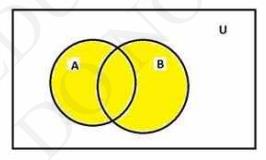
The shaded region represents \( (A \cup B) \).
We have to draw diagram for complement of \( (A \cup B) \) i.e., \( (A \cup B)^{\prime} \), which is given by \( U-(A \cup B) \).
Green region is \( (\mathrm{A} \cup \mathrm{B})^{\prime} \).
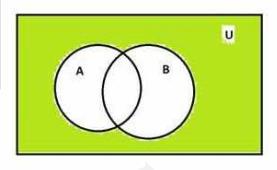
Here we have to draw diagram of \( \left(A^{\prime} \cap B^{\prime}\right) \)
So, first we draw \( A^{\prime}=(U-A) \)

Now, we draw B' (= U - B)
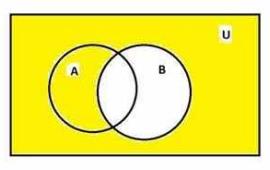
Now the area common in both the shaded regions gives us ( \( \mathrm{A}^{\prime} \cap \mathrm{B}^{\prime} \) )

Here, we observe that the final result for (i) and (ii) is same.
\(\Rightarrow(\mathrm{A} \cup \mathrm{B})^{\prime}=\left(\mathrm{A}^{\prime} \cap \mathrm{B}^{\prime}\right)\)
First we draw \( (\mathrm{A} \cap \mathrm{B}) \)
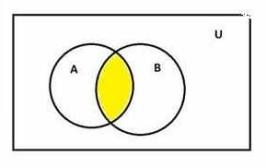
The shaded region represents \( (A \cap B) \).
We have to draw diagram for complement of \( (A \cap B) \) i.e., \( (A \cap B)^{\prime} \), which is given by \( U-(A \cap B) \)
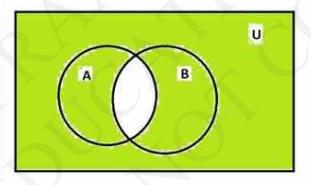
Here we have to draw diagram of ( \( A^{\prime} \cup B^{\prime} \) )
So, first we draw \( A^{\prime}=(U-A) \)
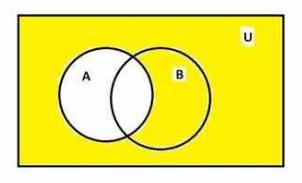
Now, we draw B' (= U - B)
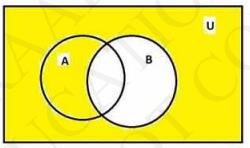
Now the area present in both is added to give ( \(\mathrm{A}^{\prime} \cup \mathrm{B}^{\prime}\))
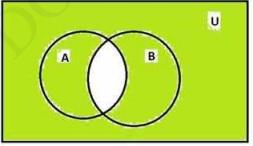
Here, we observe that the final result for (iii) and (iv) is same.
\(\Rightarrow(\mathrm{A} \cap \mathrm{B})^{\prime}=\left(\mathrm{A}^{\prime} \cup \mathrm{B}^{\prime}\right)\)
(i) \( \mathrm{A} \cup \mathrm{A}^{\prime}= \ldots\) (ii) \( \phi^{\prime} \cap \mathrm{A}= \ldots\) (iii) \( \mathrm{A} \cap \mathrm{A}^{\prime}= \ldots\) (iv) \( U^{\prime} \cap A= \ldots\)
(ii) \( \phi^{\prime} \cap \mathrm{A}=\mathrm{U} \cap \mathrm{A}=\mathrm{A} \)
\( \therefore \phi^{\prime} \cap \mathrm{A}=\mathrm{A} \)
(iii) \( \mathrm{A} \cap \mathrm{A}^{\prime}=\phi \)
(iv) \( \mathrm{U}^{\prime} \cap \mathrm{A}=\phi \cap \mathrm{A}=\phi \)
\( \therefore \mathrm{U}^{\prime} \cap \mathrm{A}=\phi \)

